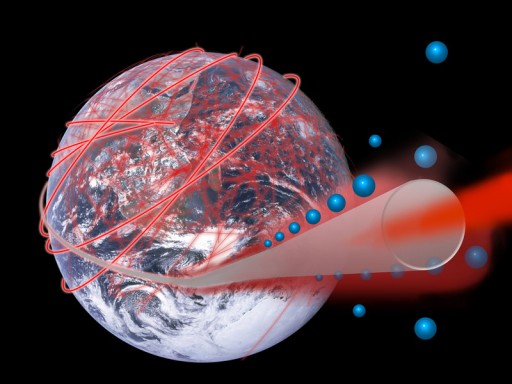A global quantum network
June 14, 2013

Atoms, coupled to a glass fiber – the basis of the worldwide communication network of the future? (credit: Vienna University of Technology)
By quantum-mechanically coupling laser-cooled atoms to glass fiber cables, Vienna University of Technology researchers have developed a way to store quantum information over a long enough period of time to allow for entangling atoms hundreds of kilometers apart via fiber cables.
This finding is a fundamental building block for a global fiber-based quantum communication network, the researchers suggest.
Atoms and light
“In our experiment, we connect two different quantum physical systems,” explains Arno Rauschenbeutel (Vienna Center for Quantum Science and Technology and Institute of Atomic and Subatomic Physics of the Vienna University of Technology). “We use fiber-guided light, which is perfect for sending quantum information from A to B, and atoms, which are ideal for storing this information.”
By trapping atoms at a distance of about 200 nanometers from a glass fiber (which itself only has a diameter of 500 nanometers), a very strong interaction between light and atoms can be implemented. This allows one to exchange quantum information between the two systems. This information exchange is the basis for technologies like quantum cryptography and quantum teleportation.
Extending coherence time
The problem with previous research is that after a short time, the quantum information stored in the atoms is lost as it leaks into the environment — an effect called “decoherence.”
The researchers were able to work around a previous limitation: light in glass fibers travels about 200 kilometers in one millisecond, a far longer distance that the nanometer distances with the atom-light combination. “Using some tricks, we were able to extend the coherence time of the atoms to several milliseconds, in spite of their small distance to the fiber surface,” explains Rauschenbeutel.
In conventional (non-quantum) fiber-based telecommunication, the range of light propagation is limited: the longer the fiber, the weaker the signal. So repeater stations are inserted into the network to amplify the optical signals after a certain distance.
Likewise, “quantum repeaters” can be used to link several shorter sections to one long quantum connection. “By using our combined nanofiber-atom-system for setting up an optical quantum network, including quantum repeaters, one might transmit quantum information and teleport quantum states around the world,” Rauschenbeutel suggests.